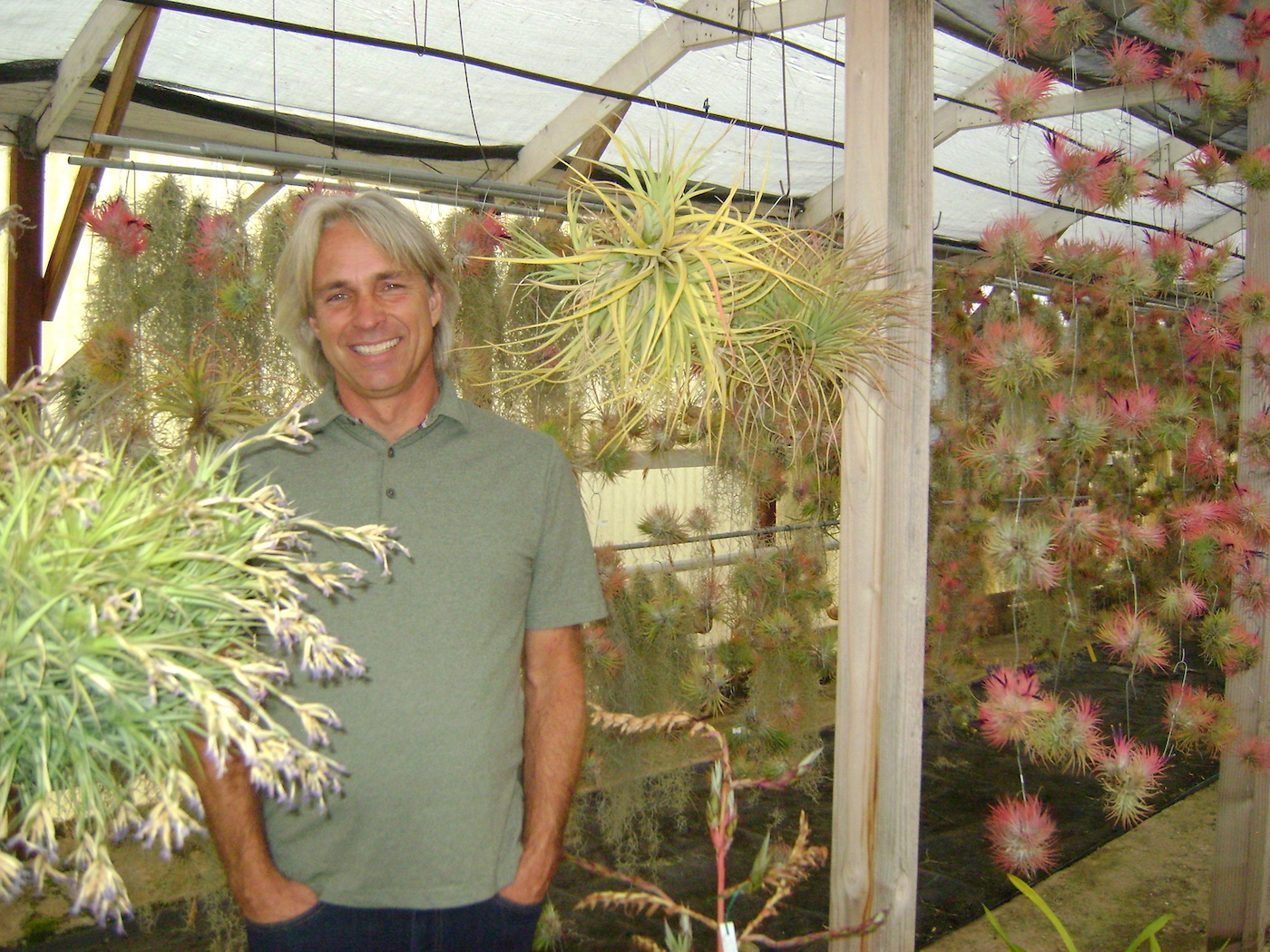Airplant Alchemy

In the film Willy Wonka & the Chocolate Factory, the candy mastermind’s base of operations first appears as a nondescript, smoke-stacked factory with no obvious hints outside as to what goes on inside. But something does; and passersby want to know what. Carpinteria’s Airplant Alchemy is like that. Owned and operated by Brian Kollenborn, a 50-something third generation Californian, the place is a unique and active den of horticultural creativity housed on three acres off Casitas Pass Road. And you’d never know what’s percolating within just by looking at it. Turning off the 192 into the facility’s graveled lot you see a few buildings, some nursery objects here and there, a couple of trucks, and then across from the parking section stands your standard, faded-siding, garden variety greenhouse. No indicators suggesting what’s in there, which is part of the fun. Which has only begun.
The day of my visit, the arrow on the large ‘Entrance’ sign pointed to a small ‘Closed’ sign and I couldn’t figure out how to open the metal door. A quick knock-knock led inside to a plant person appearing with a smile and a friendly wave. If you’re into beautiful, a little bit trippy, definitely different scenes living at the intersection of art and nature, get ready for a nice surprise.

The door rolls open onto Kollenborn’s fantastical plant kingdom. Oh, there are plants in there, but not just any green things; air plants and more varieties than you ever imagined existed. Clumps of sagey-hued curlicued things live clipped along a screened divider; spiky-spined bundles of blush and lavender-leafed specimens lie neatly spaced on low tables; carpets of mist-colored Spanish Moss cover walls and drape down from the ceiling. Some plants live nestled in vessels like snail and oyster shells, glass canisters and bubbles while others are suspended on strings. Visually, as the engagingly strange plants are arranged, the room has an avant-garde, terrestrial tidepool look, if that’s a thing.
A conversation with Kollenborn is fun and educational, full of botanical tales, scientific facts and answers to any plant question you can conjure. What are these things exactly and how do they work? “Air plants are epiphytes,” Kollenborn explained, which is to say they grow on another plant, a tree, a rock, but not in a parasitical way, simply for support. “They’re bromeliads called Tillandsias,” Kollenborn went on. “They grow without needing soil and absorb all they require through their leaves.
“They’re native to areas that don’t get a lot of hard frost. Santa Barbara’s climate is perfect for them.” The Bay Area native knows what he grows and embraces, ambitiously, the urge to invent. With his massive collection of tagged plants of various sizes, ages, configurations, and colors, Kollenborn’s cross-pollination projects have led to his becoming one of the largest air plant hybridizers in the United States. “We’ve had over ten thousand specific hybrid crosses that have been successful and we were able to collect the seed from,” he said. “Some of these things are breathtaking.”
They really are. Kollenborn’s living-organism-transformational-recipes have created, in addition to the already-existing types of Tillandsias he sells, a stunning range of plants with softly hued pigments in the foliage and flowers that bring to mind the shades of a desert sunset. No newcomer to the exotic plant world, Kollenborn was first introduced to it via his work with orchids while managing the Gazebo Plant Shop, formerly in Montecito’s Upper Village, in the mid-1980s.
“I’ve been in orchid sales and brokering since then,” he said.
“Starting in the ’90s, I acquired my first pieces of air plants from plant friends. I’d grow them in the trees in my driveway and gave a lot away as Halloween decorations sometimes.”
By 2014, his Tillandsia habit had become a serious hobby. “When I moved onto this property,” Kollenborn said, “I arrived with six tons of Spanish moss.”
As he led me on a tour through the Airplant Alchemy greenhouses, Kollenborn pointed out unique features, textures, and tendencies of his wonderfully weird collection of plants. The silvery-grey-green Duratii, for instance, has long leathery leaf-arms that extend in the direction it wants to go. “It pulls itself up the tree,” he said, then showed me teeny plants, less than an inch, that he’d raised from seed.
“This is two years’ worth of growth,” he said, and the Tectorum, a soft, frosty-white snowball of a plant, is “super fuzzy and fun.” (To be honest, the cutest plant I’ve ever seen.) Easy to care for and fascinating in appearance, Tillandsias don’t need much in order to thrive; only good bright light (not direct sun exposure) and a bath every week or so. Just pop the plant in a bowl of water for five to ten minutes, take it out, flip it over to drain, hang it up to dry and the fella’s good to go. Airplant Alchemy’s retail showroom has only been open to the public since 2019 and once COVID-19 came around the business started moving into online sales, as well. But, the store remains open and “we follow safe practices and COVID-safeguards,” Kollenborn said. To visit the nursery, check the website (airplantalchemy.com) for hours and just stop by. No Golden Ticket required.







You must be logged in to post a comment.